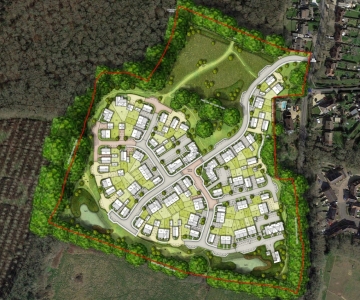Catesby Estates are currently reviewing the new National Planning Policy Framework (NPPF) which was announced earlier this week.
We will be looking at the specific potential implications on the current planning strategy for land sites within our portfolio, and how we will be moving forward with the ongoing promotion of these sites.
The key headlines include:
Action Against Local Planning Authorities Who Don’t Deliver
A range of interventions have been announced which state that the Government intends to, amongst others speed up the planning application process:
- The Government will clearly identify good practice and the worst offenders for planning applications through the use of league tables.
- The Government will look into the use of Extension of Time agreements and will consult on limiting use of them and prohibiting repeat use.
- The worst offenders for overturning the decisions of planners or spending large amounts on fighting appeals or awarding costs to developers will be highlighted.
- The higher levels of expectation for planning departments will require additional resource, so further funding to support and reward planners in local Government will be provided.
- Due to planning fee increases, the Government expect spending for planning services to rise.
Local Housing Need (The Standard Method)
- The new NPPF makes clear that the outcome of the standard method is an advisory starting point in plan making for establishing the housing requirements for an area. Some local authorities may wish to deliver more homes if they want to improve economic growth for example.
- The revised NPPF provides clarity on what may constitute such exceptional circumstances for using an alternative method to assess housing need, including the particular demographic characteristics of an area i.e. to reduce the housing requirement for an area.
Green Belt
- There is generally no requirement on local authorities to review or alter Green Belt boundaries if this would be the only way to meet housing need, which is a different emphasis from the previous version.
- Where a Council chooses to conduct a review, existing national policy will continue to expect that Green Belt boundaries are only altered where ‘exceptional circumstances’ are fully evidenced and justified, and this should only be through the preparation or updating of plans.
- As such the basic test is the same as before, and Councils weren’t really compelled to remove sites from the Green Belt in any event. As such, after a period of bedding down, we expect Councils to carry on with local plans releasing land from the green belt for development, albeit potentially with less sites being allocated.
Character And Beauty
- The new NPPF recognises that there may be situations where significant uplifts in residential densities would be inappropriate as they would be “wholly out of character” with the existing area, and that this may in turn affect how much development can be planned for in the area concerned. This will apply where there is a design code which is adopted or will be adopted as part of the local plan.
- This arguably justifies development in the green belt, to assist in meeting their housing needs if they are unable to build at a higher density in the urban area.
Five-Year Housing Land Supply
- The first and important point to make is that this test remains, albeit with significant alterations.
- The Government considers an up-to-date local plan to be a plan that is less than five years old, which contains a deliverable five-year supply of land at conclusion of its examination. All planning authorities are required to maintain a five-year supply of land to ensure homes and wider developments are built in the right places.
- The Government is removing the requirement for planning authorities that have put an up-to-date plan in place to update annually their five-year supply of land.
- A transitional arrangement will ensure that decision making on live applications is not affected, avoiding disruption to applications in the system that were submitted prior to the NPPF being released.
- Local plans at examination, Regulation 18, or Regulation 19 stage with a policy map and proposed allocations towards meeting housing need only have to demonstrate a four-year housing land supply (as opposed to five years) for a period of two years from the release of the NPPF.
- For those who do not have an up to date plan, they will be required to update their supply annually. If they fail to do so, they will therefore be subject to the presumption in favour of sustainable development as previously imposed.
Neighbourhood Plans
- The new NPPF in theory protects neighbourhood plans from ‘speculative development’ from the current two years to five years, where those plans allocate at least one housing site.
- However, this section has already been amended, as the Government admitted there was drafting error in the text and we wait to see how Councils will see this change, particularly if there is an imbalance of neighbourhood plan coverage in the area.
We look forward to working with our landowner partners in the New Year.
Wishing you all a Merry Christmas and a prosperous New Year.




